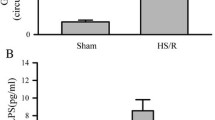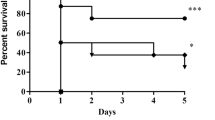Abstract
Objective
This study investigated the role of 5-lipoxygenase in the pathogenesis of multiple organ failure (MOF) induced by zymosan.
Design
Male mice with a targeted disruption of the 5-lipoxygenase gene (5-LOKO) and littermate wild-type (WT) controls (5-LOWT) were used to evaluate the role of 5-lipoxygenase (5-LO) in the pathogenesis of MOF.
Setting
University research laboratory.
Interventions and measurements
MOF was induced by peritoneal injection of zymosan (500 mg/kg i.p. as a suspension in saline) in 5-LOWT and in 5-LOKO mice. MOF was assessed 18 h after administration of zymosan and monitored for 12 days (for loss of body weight and mortality).
Results
A severe inflammatory process induced by zymosan administration in WT mice coincided with the damage of lung and small intestine, as assessed by histological examination. Myeloperoxidase activity indicative of neutrophil infiltration and lipid peroxidation were significantly increased in zymosan-treated WT mice. Zymosan in the WT mice also induced a significant increase in the plasma level of nitrite/nitrate. Immunohistochemical examination demonstrated a marked increase in the immunoreactivity to ICAM-1 and P-selectin in the lung and intestine of zymosan-treated WT mice. In contrast, the degree of (a) peritoneal inflammation and tissue injury, (b) upregulation/expression of P-selectin and ICAM-1, and (c) neutrophil infiltration were markedly reduced in intestine and lung tissue obtained from zymosan-treated 5-LO deficient mice. Zymosan-treated 5-LOKO showed also a significantly decreased mortality.
Conclusions
These findings clearly demonstrate that 5-LO exerts a role in zymosan-induced nonseptic shock.





Similar content being viewed by others

References
American College of Chest Physicians/Society of Critical Care Medicine Consensus Conference Committee (1992) Definitions for sepsis and organ failure and guidelines for the use of innovative therapies in sepsis. Crit Care Med 20:864–874
Baue AE, Durham R, Faist E (1998) Systemic inflammatory response syndrome (SIRS), multiple organ dysfunction syndrome (MODS), multiple organ failure (MOF): are we winning the battle? Shock 10:79–89
Marshall JC (2001) Inflammation, coagulopathy, and the pathogenesis of multiple organ dysfunction syndrome. Crit Care Med 29:S99–S106
Deitch EA (2000) Role of the gut lymphatic system in multiple organ failure. Curr Opin Crit Care 7:92–98
Volman TJ, Goris RJ, van der Jagt M, van de Loo FA, Hendriks T (2002) Organ damage in zymosan-induced multiple organ dysfunction syndrome in mice is not mediated by inducible nitric oxide synthase. Crit Care Med 30:1553–1559
Van Bebber IPT, Boekholz KF, Goris RJA, Schillings PHM, Binges HP, Bahrami S, Redl H, Schlag G (1989) Neutrophil function and lipid peroxidation in rat model of multiple organ failure. J Surg Res 47:471–475
Petit F, Bagby GJ, Lang CH (1996) Tumour necrosis factor mediates zymosan induced increase in glucose flux and insulin resistance. Am J Physiol 268:E219–E228
Deitch EA, Ma L, Berg RD, Specian RD (1990) Protein malnutrition predisposes to inflammatory-induced gut-origin septic states. Ann Surg 221:560–568
Goris RJA, Van Bebber IPT, Mollen RMH, Koopman JP (1991) Dose selective decontamination of the gastrointestinal tract prevent multiple organ failure? Arch Surg 126:561–565
Mainous MR, Ertel W, Chaudry IH, Deitch EA (1995) The gut: a cytokine-generating organ in systemic inflammation? Shock 4:193–199
Cuzzocrea S, De Sarro GB, Costantino G, Mazzon E, Laurà R, Ciriaco E, De Sarro A, Caputi AP (1999) Role of interleukine-6 in a non-septic shock model induced by zymosan. Eur Cytokine Netw 10:191–203
Cuzzocrea S, Mazzon E, Dugo L, Barbera A, Centorrino T, Ciccolo A, Fonti MT, Caputi AP (2001) Inducible nitric oxide synthase knock out mice exhibit a resistance to multiple organ failure induced by zymosan. Shock 16:51–58
Devchand PR, Arita M, Hong S, Bannenberg G, Moussignac RL, Gronert K, Serhan CN (2003) Human ALX receptor regulates neutrophil recruitment in transgenic mice: roles in inflammation and host defense. FASEB J 17:652–659
Kolaczkowska E, Shahzidi S, Seljelid R, van Rooijen N, Plytycz B (2002) Early vascular permeability in murine experimental peritonitis is co-mediated by resident peritoneal macrophages and mast cells: crucial involvement of macrophage-derived cysteinyl-leukotrienes. Inflammation 26:61–71
Haribabu B, Verghese MW, Steeber DA, Sellars DD, Bock CB, Snyderman R (2000) Targeted disruption of the leukotriene B (4) receptor in mice reveals its role in inflammation and platelet-activating factor-induced anaphylaxis. J Exp Med 192:433–438
Dahlen SE (1998) Lipid mediator pathways in the lung: leukotrienes as a new target for the treatment of asthma. Clin Exp Allergy 5:141–146
Goulet JL, Byrum RS, Key ML, Nguyen M, Wagoner VA, Koller BH (2000) Genetic factors determine the contribution of leukotrienes to acute inflammatory responses. J Immunol 164:4899–4907
Byrum RS, Goulet JL, Snouwaert JN, Griffiths RJ, Koller BH (1999) Determination of the contribution of cysteinyl leukotrienes and leukotriene B4 in acute inflammatory responses using 5-lipoxygenase- and leukotriene A4 hydrolase-deficient mice. J Immunol 163:6810–5819
Gardinali M, Borrelli E, Chiara O, Lundberg C, Padalino P, Conciato L, Cafaro C, Lazzi S, Luzi P, Giomarelli PP, Agostoni A (2000) Inhibition of CD11-CD18 complex prevents acute lung injury and reduces mortality after peritonitis in rabbits. Am J Respir Crit Care Med 161:1022–1029
Heller AR, Fiedler F, Braun P, Stehr SN, Bodeker H, Koch T (2003) Clusterin protects the lung from leukocyte-induced injury. Shock 20:166–170
Swartz DE, Seely AJ, Ferri L, Giannias B, Christou NV (2000) Decreased systemic polymorphonuclear neutrophil (PMN) rolling without increased PMN adhesion in peritonitis at remote sites. Arch Surg 135:959–966
Tsujimoto H, Ono S, Mochizuki H, Aosasa S, Majima T, Ueno C, Matsumoto A (2002) Role of macrophage inflammatory protein 2 in acute lung injury in murine peritonitis. J Surg Res 103:61–67
Grutkoski PS, Graeber CT, Ayala A, Simms HH (2002) Paracrine suppression of apoptosis by cytokine-stimulated neutrophils involves divergent regulation of NF-kappaB, Bcl-X (L), and Bak. Shock 2002 17:47–54
Cuzzocrea S, Rossi A, Serraino I, Mazzon E, Di Paola R, Dugo L, Genovese T, Calabro B, Caputi AP, Sautebin L (2003) 5-Lipoxygenase knockout mice exhibit a resistance to pleurisy and lung injury caused by carrageenan. J Leukoc Biol 73:739–746
Baue AE (1993) The multiple organ or system failure syndrome. In: Schlag G, Redl H (eds) Pathophysiology of shock, sepsis, and organ failure. Springer, Berlin Heidelberg New York, pp 1004–1018
Ohkawa H, Ohishi N, Yagi K (1979) Assay for lipid peroxides in animal tissues by thiobarbituric acid reaction. Anal Biochem 95:351–358
Cuzzocrea S, Filippelli A, Zingarelli B (1997) Role of nitric oxide in a non-septic shock model induced by zymosan in the rat. Shock 351–358
Demling R, Nayak U, Ikegami K (1994) Comparison between lung and liver peroxidation and mortality after zymosan peritonitis in the rats. Shock 2:222–227
Vliet A van der, van der Poel KI, Bast A (1992) Intestinal smooth muscle dysfunction after intraperitoneal injection of zymosan in the rat: are oxygen radicals involved? Gut 33:336–341
Cuzzocrea S, Riley DP, Caputi AP, Salvemini D (2001) Antioxidant therapy: a new pharmacological approach in shock, inflammation, and ischemia/reperfusion injury. Pharmacol Rev 53:135–159
Cuzzocrea S, Rossi A, Serraino I, Di Paola R, Dugo L, Genovese T, Caputi AP,Sautebin L (2003) 5-Lipoxygenaseknock out mice exhibit a resistance to splanchnic artery occlusion (SAO) shock. Shock 20:230–236
Cuzzocrea S, Rossi A, Serraino I, Di Paola R, Dugo L, Genovese T, Britti D, Sciarra G, De Sarro A, Caputi AP,Sautebin L (2003) 5-lipoxygenaseknock out mice exhibit a resistance to the acute pancreatitis induced by cerulein. Immunology 110:120–130
Coffey MJ, Phare SM, Peters-Golden M (2002) Interaction between nitric oxide, reactive oxygen intermediates, and peroxynitrite in the regulation of 5-lipoxygenase metabolism. Biochim Biophys Acta 1584:81–90
Vicente AM, Guillen MI, Alcaraz MJ (2001) Modulation of haem oxygenase-1 expression by nitric oxide and leukotrienes in zymosan-activated macrophages. Br J Pharmacol 133:920–926
Fermor B, Haribabu B, Weinberg JB, Pisetsky DS, Guilak F (2001) Mechanical stress and nitric oxide influence leukotriene production in cartilage. Biochem Biophys Res Commun 285:806–810
Tadimeti S. Rao, Jerry L, Currie, Shaffer Peter C, Isakson (1994) In vivo characterization of zymosan-Induced mouse peritoneal inflammation. J Pharmacol Exp Ther 269:917–925
Issekutz AC, Issekutz TB (2002) The role of E-selectin, P-selectin, and very late activation antigen-4 in T lymphocyte migration to dermal inflammation. J Immunol 168:1934–1939
Wetheimer SJ, Myers CL, Wallace RW, Parks TP (1992) Intercellular adhesion molecule-1 gene expression in human endothelial cells. J Biol Chem 267:12030–12035
Acknowledgements
The authors thank Giovanni Pergolizzi and Carmelo La Spada for their excellent technical assistance during this study, Mrs. Caterina Cutrona for secretarial assistance, and Miss Valentina Malvagni for editorial assistance with the manuscript.
Author information
Authors and Affiliations
Corresponding author
Electronic Supplementary Material
Rights and permissions
About this article
Cite this article
Cuzzocrea, S., Rossi, A., Serraino, I. et al. Role of 5-lipoxygenase in the multiple organ failure induced by zymosan. Intensive Care Med 30, 1935–1943 (2004). https://doi.org/10.1007/s00134-004-2353-y
Received:
Accepted:
Published:
Issue Date:
DOI: https://doi.org/10.1007/s00134-004-2353-y



